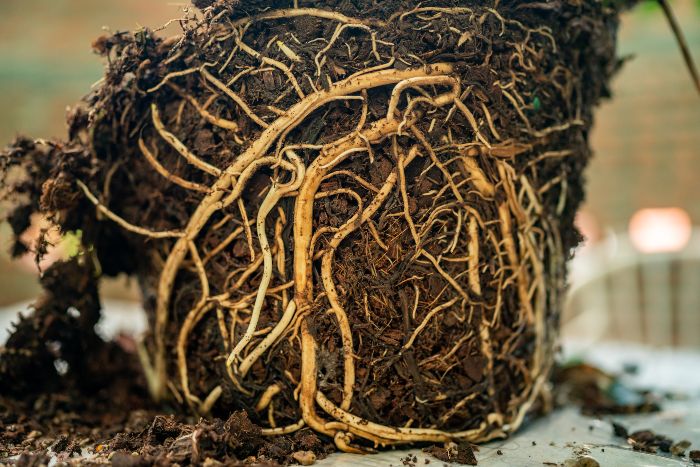
Root rot is a common yet potentially devastating issue affecting trees, leading to their decline and even death if severe and untreated. This comprehensive guide will delve into the essential aspects of root rot, emphasizing prevention and treatment. Understanding the causes, diagnosis, and effective management of root rot is crucial for maintaining the health and longevity of trees in your landscape.
What is Root Rot?
Root rot is a fungal disease that affects a tree’s roots, primarily caused by various types of fungi, including but not limited to Armillaria, Phytophthora, and Fusarium. Recognizing the signs of root rot is crucial for early intervention. Symptoms may include:
- Leaf discoloration and wilt
- Premature leaf drop
- Stunted growth
- Canopy dieback
- Cankers or lesions near the tree’s base
- Sulfuric or “eggy” smell from the soil
- A general decline in tree health
Our Tree Pest and Disease Management page has more info on common diseases, including root rot.
Inspect the Roots
To inspect trees for root rot, it’s crucial to examine the roots. Gently excavate the soil around the tree’s base, inspecting the roots for any signs of decay, discoloration, or a foul odor. Healthy roots are firm, white, or light-colored, while affected roots appear dark and mushy and may emit an unpleasant smell. Additionally, look for cankers, lesions, or signs of fungal growth near the root collar.

Root Rot Causes
The leading causes of root rot can be attributed to three primary factors: overwatering, poor drainage, and poor air circulation.
Overwatering
Overwatering is the main culprit, as excessive moisture in the soil creates a cool, wet environment conducive to fungal growth. That’s why most mushrooms pop up in the fall or spring when the climate is mild and damp. But these growing conditions ideal for fungi harm tree roots, slowly killing and stressing the entire tree. This weakens the tree’s defense mechanisms, enabling fungi to attack further and decay the root system, ultimately compromising the tree’s health and vitality.
Poor Drainage
Poor drainage in the soil exacerbates overwatering issues because the excess water has difficulty draining away from the tree’s root zone. Some soils, like sand, drain very quickly, but others, like compacted soils and clay soils, drain much more slowly. These soil types have more tightly packed soil particles that inhibit water flow. As previously discussed, wet soil conditions are conducive to fungi but harmful to tree roots, increasing the chances of root rot.
Poor Air Circulation
Poor air circulation around the root system can also impede the tree’s ability to resist infections and stay healthy. One of the reasons oversaturated soils damage tree roots is that there’s less soil space available for air and oxygen. Although this may seem surprising, roots need a consistent oxygen supply to metabolize and grow. Cutting off airflow suffocates tree roots, but fungi require less or no oxygen for growth, so they take advantage of weakened trees and cause root rot.
How to Prevent and Treat Root Rot
Addressing root rot involves a multifaceted approach. Preventative measures are vital, such as avoiding over-irrigation and improving proper drainage. Here are some tips to prevent root rot and reverse mild cases of root rot.
Avoid Overwatering
To avoid overwatering your trees, understand the traits of your tree species, such as if it’s water-loving or drought-tolerant. Also, remember that more mature trees need less frequent but deeper watering than young trees. Below are some general rules of thumb:
Newly Planted Trees
- First 3 months: Water 2x a week.
- After 3 months: Water 1x a week until roots are established (up to 2 years)
- Apply 2-3 gallons of water each time.
Established Trees
- Hot, dry weather: Water about 1x a week.
- Cool-weather: Water about 1x a month.
- Water until about the top 18 inches of soil are moist.
Improve Soil Drainage
Improving soil drainage helps prevent standing water accumulation and encourages oxygen flow. Both create an environment less hospitable for fungal growth but more beneficial for tree root growth. To achieve better soil drainage, it’s necessary to improve soil structure, which can be done by adding soil amendments like organic matter and biochar.
Organic Matter: Using amendments high in organic matter, like compost or wood mulch, reduces compaction while also adding essential nutrients to the soil, a win-win! But remember that mulch around trees should be applied carefully because mulch piled against the root flare traps moisture and encourages trunk rot, which can lead to root rot.
Biochar is a carbon-rich byproduct of wood waste and has an open structure, much like a sponge or honeycomb. Biochar’s unique trait helps resist soil compaction and has the added benefit of providing a habitat for beneficial microbes. These helpful fungi and bacteria decompose organic matter and fight off or compete against decay fungi.
In conclusion, the prevention and treatment of root rot are essential to maintaining the health and vitality of trees. By addressing the root causes, recognizing the symptoms, and employing appropriate preventative and treatment measures, we can mitigate the impact of root rot on our trees. Vigilance, proper care, and a proactive approach are crucial in safeguarding trees from this detrimental disease. In severe cases, professional intervention and the guidance of an arborist may be necessary.
Frequently Asked Questions





